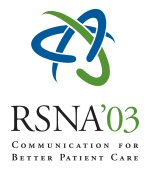
Abstract Archives of the RSNA, 2003
Q18-1357
Use of a Thin Client to Distribute Advanced 3D Postprocessing Capabilities throughout the Radiology Enterprise
Scientific Papers
Presented on December 4, 2003
Presented as part of Q18: Radiology Informatics (PACS: Projects)
Eric Tamm MD, PRESENTER: Nothing to Disclose
Abstract:
HTML
Advanced postprocessing techniques, such as Volume Rendering (VR), and
multiplanar reformations (MPR) coupled with the thin section imaging available
with multidetector CT (MDCT) offer new perspectives for abdominal imaging.
Unfortunately, the traditional paradigm has been the review of axial images on
PACS stations, and the construction of post processed images on advanced
workstations which have typically been in a separate location. To eliminate
this separation, several manufacturers are now offering to incorporate entire
postprocessing workstation programs, usually with limitations, into PACS
workstations. However, this approach demands significant hardware requirements,
and typically a high cost to upgrade to this capability for every workstation.
We present in this abstract our experience with a client-server model for
distributing advanced postprocessing capabilities to a wide range of computers.
The AquariusNET Server (TeraRecon , San Mateo, CA) utilizes hardware and
software to perform advanced postprocessing in real time; users interact with
the server via a thin client that can be downloaded using a web browser. Our
instititution is currrently implementing the iSite (Stentor, Inc., Brisbane,
CA) PACS solution for filmless reading for our Radiology Department. We have
found that the AquariusNET thin client is capable of running simultaneously on
the same computer platform as that running the Stentor PACS workstation without
modification of hardware. It was possible from the Stentor PACS workstation to
direct the Stentor PACS Archive to push images to the AquariusNET Server, to
interactively direct the AquariusNET Server to create and view complex 3D VR
images while using the PACS workstation, and to then push selected images to
the Stentor Archive for distribution to our clinicians via the institution's
self-developed Clinicstation application that incorporates Stentor for image
viewing. We were also able to use the thin client on radiologists' office
computers, and conference room computers with LCD projectors. Using this
approach, it has been possible to routinely create complex postprocessed images
on office computers for clinical, and academic purposes. Similarly it has been
possible to perform real time complex postprocessing during case conferences to
answer clinical questions (i.e., length of superior mesenteric vein involvement
by pancreatic cancer), and to then transfer key images to the PACS archive for
later retrieval by clinicians using Clinicstation.
To learn about the capabilities of using a thin client application for
distributing advanced postprocessing capabilities for Multidetector CT data
throughout the enterprise.(E.P.T. TeraRecon has loaned a workstation and the
AQNET server for evaluation purposes to MD Anderson.)
Tamm MD, E,
Use of a Thin Client to Distribute Advanced 3D Postprocessing Capabilities throughout the Radiology Enterprise. Radiological Society of North America 2003 Scientific Assembly and Annual Meeting, November 30 - December 5, 2003 ,Chicago IL.
http://archive.rsna.org/2003/3105093.html

